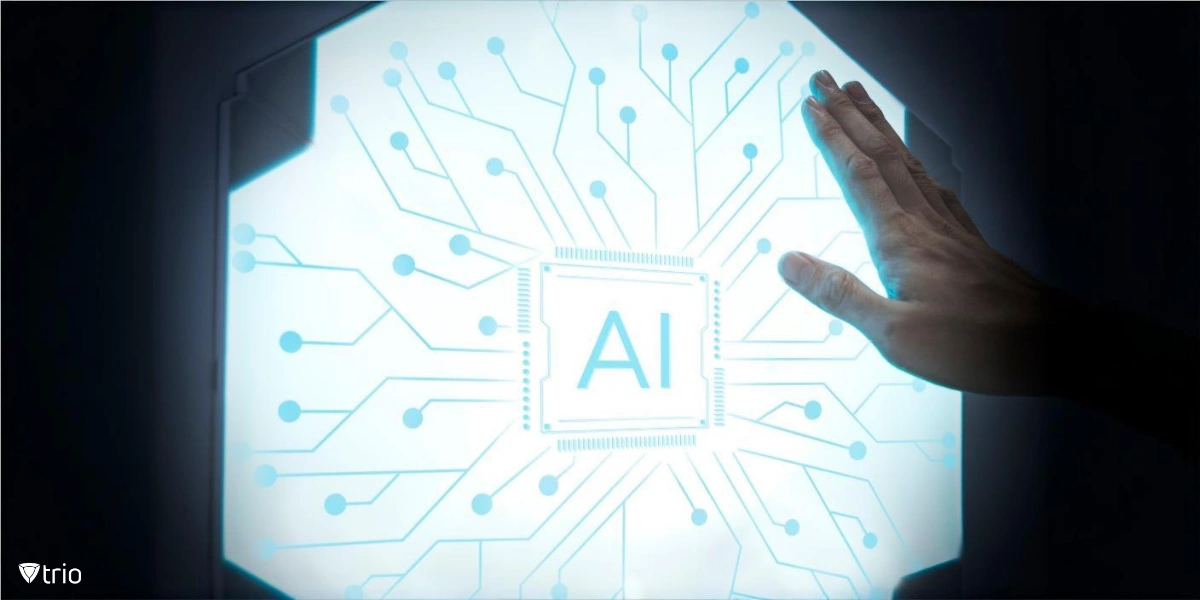Generative AI is reshaping cybersecurity, allowing organizations to anticipate, detect, and respond to cyber threats with unmatched efficiency. As cyberattacks grow more sophisticated, the role of AI has become critical for businesses safeguarding their digital infrastructure. This article explores how generative AI enhances cybersecurity, its benefits, and the challenges it presents.
What Is Generative AI in Cybersecurity?
Generative AI, a subset of artificial intelligence, focuses on creating new data or patterns based on existing datasets. This capability has revolutionized various industries, including cybersecurity. By analyzing historical data, generative AI identifies patterns in cyber threats, predicts vulnerabilities, and simulates attack scenarios to improve defenses.
How Generative AI Works in Cybersecurity
Generative AI relies on machine learning models, particularly deep learning and neural networks. These systems analyze extensive datasets, enabling them to detect anomalies and predict cyber threats.
- Data Training: Models are trained on past cybersecurity data to recognize patterns in threats and vulnerabilities.
- Pattern Recognition: AI detects deviations from expected behavior, identifying potential risks.
- Proactive Analysis: Generative AI suggests preventative measures, enhancing security frameworks.
Enhancing Threat Detection and Response
Generative AI transforms how organizations handle threat detection and response. By learning from historical incidents, AI models can pinpoint attack patterns and anomalies that traditional methods might miss.
Proactive Threat Detection
Generative AI excels at shifting from reactive to proactive threat detection. By studying past attacks, AI systems can predict vulnerabilities and recommend actions to prevent breaches.
- Example: AI-driven tools identify phishing attempts by analyzing subtle irregularities in email content.
- Outcome: Organizations reduce downtime and financial damage by addressing threats before they escalate.
Real-Time Response Capabilities
During an attack, generative AI accelerates response by providing actionable insights and automating initial steps. Tasks such as isolating compromised systems or suggesting containment measures become faster and more precise.
Automating Routine Cybersecurity Tasks
Generative AI effectively handles repetitive, time-consuming tasks, allowing cybersecurity teams to focus on more strategic efforts.
Streamlining Security Protocols
AI systems automate tasks like configuring firewalls, scanning for vulnerabilities, and enforcing policies. This ensures consistency while reducing the chance of human error.
- Efficiency: Teams manage higher workloads without proportional increases in staff.
- Accuracy: Automation minimizes discrepancies in threat management practices.
Automating Incident Reporting
Generative AI synthesizes data from multiple sources to create clear, concise reports. These reports provide insights into attack trends, potential risks, and response effectiveness, improving decision-making processes.
Training and Augmenting Human Analysts
Generative AI serves as a tool to amplify the capabilities of human analysts, rather than replace them. It enhances their productivity and provides realistic training environments.
Scenario-Based Training
Generative AI creates lifelike simulations of cyberattacks, helping analysts develop problem-solving skills. These dynamic scenarios evolve with emerging threats, offering practical, hands-on experience.
- Practical Application: Trainees engage with AI-generated simulations to refine their strategies.
- Benefit: Teams gain the expertise needed to handle increasingly complex cyber threats.
Force Multiplication
By automating lower-priority tasks, generative AI frees human analysts to concentrate on more challenging problems. This is particularly beneficial given the ongoing shortage of skilled cybersecurity professionals.
Applications of Generative AI in Cybersecurity
The adaptability of generative AI has led to its integration into multiple facets of cybersecurity operations.
Phishing Detection and Prevention
Generative AI evaluates communication patterns to uncover phishing attempts, even those crafted to mimic legitimate interactions. Drawing on past data, AI tools flag suspicious messages before users encounter them. A recent survey indicates that 55% of organizations plan to adopt generative AI solutions within the next year.
Data Masking and Privacy Preservation
Through synthetic data generation, AI protects sensitive information while training and testing systems. This approach ensures robust models without risking data privacy.
Behavior Analysis and Anomaly Detection
AI models establish baselines for normal user and network activity, identifying deviations that could signal breaches or unauthorized access.
Generative AI in Security Operations Centers (SOCs)
Security operations centers are integrating generative AI to improve their effectiveness and reduce the workload on human teams.
Advanced Analytics for Incident Management
AI models analyze incident data in real time, offering actionable recommendations for response and recovery. This accelerates containment efforts and improves system resilience.
Integrating AI into Security Event and Incident Management (SEIM)
Generative AI enhances SEIM systems by analyzing event data comprehensively, helping teams pinpoint threats more quickly and accurately.
Challenges of Generative AI in Cybersecurity
While the potential of generative AI is immense, its implementation in cybersecurity comes with hurdles that organizations must address.
High Computational Requirements
Training and deploying AI models demand significant computational resources, which can be a barrier for smaller organizations.
Potential for Misuse
Generative AI's powerful capabilities can also be exploited by malicious actors. Cybercriminals might use it to craft advanced phishing schemes or malware that adapts to evade detection.
Addressing Risks and Ethical Concerns
Organizations adopting generative AI need to address the associated risks and ensure ethical practices in its use.
Mitigating Shadow AI
Shadow AI refers to unsanctioned tools used without organizational oversight. Establishing clear policies and providing approved AI tools can help mitigate these risks.
Ensuring Transparency and Trust
Building trust in AI systems involves maintaining transparency, implementing strong safety measures, and regularly evaluating their effectiveness against organizational goals.
The Double-Edged Nature of Generative AI
Generative AI provides organizations with advanced tools to detect and prevent cyberattacks, but it also creates new opportunities for malicious actors. The dual-use nature of this technology has raised concerns about how it can be weaponized.
Cybercriminal Exploitation of Generative AI
Attackers are leveraging generative AI to enhance their methods, making them more deceptive and harder to detect. For instance, AI can create phishing emails that mimic legitimate communication, reducing the chances of detection. Similarly, cybercriminals use AI-generated deepfakes to manipulate victims or bypass security measures.
- Sophisticated Malware Development: Generative AI allows attackers to create malware capable of evolving and adapting to evade traditional security tools.
- Automated Attacks: AI-driven systems enable large-scale, automated attacks that are faster and more complex than those executed manually.
Balancing the Scale
While attackers exploit generative AI, defenders can use the same tools to counteract threats. Organizations are adopting AI systems to predict and neutralize malicious activities before they escalate. However, this requires continuous innovation to stay ahead in the cybersecurity arms race.
Securing the AI Pipeline
Organizations implementing generative AI must secure the entire lifecycle of their AI systems. From training data to deployment, vulnerabilities in the AI pipeline could be exploited if not addressed.
Protecting Training Data and Models
The datasets used to train generative AI models often contain sensitive information. Ensuring that this data is anonymized and securely stored is critical. Additionally, organizations must guard against unauthorized access to AI models, as attackers could tamper with them or introduce backdoors.
Ensuring Model Integrity
AI systems need to be continuously monitored for signs of manipulation or exploitation. This includes protecting against model poisoning, where attackers feed malicious data into the training process to compromise the system.
Continuous Evaluation and Updates
The threat landscape evolves rapidly, and AI models must be updated regularly to remain effective. Organizations should implement processes to evaluate their systems, ensuring they align with current security standards and best practices.
Generative AI’s Role in Incident Response
Generative AI is playing a pivotal role in improving incident response workflows. By automating key steps and providing actionable insights, it enhances the speed and accuracy of responses to security incidents.
Automating Initial Responses
When a breach occurs, AI can immediately analyze the situation and suggest mitigation strategies. For example, it can isolate compromised systems to prevent the spread of malware or recommend countermeasures based on historical data.
Simulating Response Strategies
Generative AI enables cybersecurity teams to test different response scenarios, helping them identify the most effective approach. By simulating attacks and defenses, teams can refine their strategies and improve decision-making during real incidents.
Improving Post-Incident Reporting
After an incident is resolved, generative AI streamlines the creation of comprehensive reports. These reports include detailed analyses of the attack, the steps taken to mitigate it, and recommendations for future improvements.
Predictions for Generative AI in Cybersecurity
As generative AI continues to evolve, its influence on cybersecurity is expected to grow. Organizations are preparing for both the opportunities and challenges it presents in the years ahead.
Anticipated Trends
- More Sophisticated Defenses: AI systems will become better at identifying and countering advanced threats, including those that use AI themselves.
- Increased Collaboration: Cybersecurity vendors and organizations will collaborate to develop standardized AI tools and protocols, ensuring widespread adoption and interoperability.
- Stronger Regulatory Oversight: Governments and industry groups are likely to introduce regulations governing the ethical use of AI in cybersecurity, addressing concerns about privacy and misuse.
Preparing for the Future
Organizations must invest in training their teams to work alongside generative AI systems effectively. This includes equipping employees with the skills to interpret AI-generated insights and make informed decisions.
Remaining Challenges
While generative AI offers significant benefits, challenges such as ethical considerations, potential misuse, and resource limitations must be addressed. Organizations need to adopt a balanced approach, leveraging AI’s capabilities responsibly while safeguarding against its risks.
Building Trust in Generative AI
For generative AI to succeed in cybersecurity, organizations must establish trust in the technology. This involves demonstrating its reliability, transparency, and alignment with organizational goals.
Transparency in AI Operations
Organizations should be open about how their AI systems function, including the data used for training and the algorithms behind decision-making processes. This transparency helps build confidence among stakeholders.
Ongoing Risk Management
AI systems must be regularly evaluated to identify potential risks and ensure they remain effective. This includes addressing issues such as bias, inaccuracies, and susceptibility to manipulation.
Human Oversight
Generative AI should complement, not replace, human expertise. By maintaining human oversight, organizations can ensure that AI systems are used ethically and effectively, reducing the risk of unintended consequences.
Conclusion
Generative AI is changing how organizations approach cybersecurity, providing tools to detect, prevent, and respond to threats with greater precision and speed. Its ability to process large volumes of data, identify patterns, and automate routine tasks has made it an essential part of cybersecurity planning. However, adopting generative AI involves more than technical know-how. Organizations must address ethical challenges, prevent misuse, and ensure smooth integration into existing systems.
As attackers use similar technologies to create more advanced methods of intrusion, organizations face the dual challenge of strengthening defenses while staying adaptable. Transparency, well-designed safeguards, and human oversight are necessary to ensure AI tools align with the broader goals of security and trust. These elements are not just about enhancing technology but also about building confidence among stakeholders and safeguarding sensitive information.
Generative AI’s role in cybersecurity will continue to grow as technology advances. The organizations that prioritize training, invest in thoughtful implementation, and foster collaboration will be well-positioned to make the most of these tools.
While challenges remain, the potential benefits are clear: better security measures, faster responses to threats, and a proactive approach to risk management. With careful planning and responsible use, generative AI can provide the foundation for stronger and more reliable cybersecurity systems.
Get Ahead of the Curve
Every organization today needs a solution to automate time-consuming tasks and strengthen security.
Without the right tools, manual processes drain resources and leave gaps in protection. Trio MDM is designed to solve this problem, automating key tasks, boosting security, and ensuring compliance with ease.
Don't let inefficiencies hold you back. Learn how Trio MDM can revolutionize your IT operations or request a free trial today!





